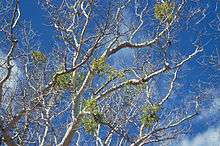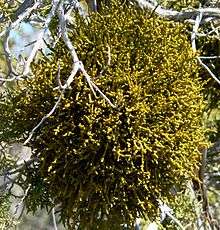Phoradendron
| Phoradendron | |
|---|---|
 | |
| Phoradendron californicum fruit | |
| Scientific classification | |
| Kingdom: | Plantae |
| (unranked): | Angiosperms |
| (unranked): | Eudicots |
| (unranked): | Core eudicots |
| Order: | Santalales |
| Family: | Viscaceae |
| Genus: | Phoradendron Nutt.[1] |
| Species | |
|
about 235-240; see text | |
| Synonyms | |
|
Allobium Miers | |

Phoradendron is a genus of mistletoes, native to warm temperate and tropical regions of the Americas. The center of diversity is the Amazon rainforest.[2] Traditionally, the genus has been placed in the family Viscaceae, but recent genetic research acknowledged by the Angiosperm Phylogeny Group shows this family to be correctly placed within a larger circumscription of the sandalwood family, Santalaceae.
They are woody hemi-parasitic shrubs with branches 10–80 cm (3.9–31.5 in) long, which grow on other trees. The foliage is dichotomously branching, with opposite pairs of leaves; these are fairly large, 2–5 cm (0.79–1.97 in) long, green and photosynthetic in some species (e.g. P. leucarpum), but minimal in some others (e.g. P. californicum). Although they are able to photosynthesize the plant relies on its host for some nutrients. The plant draws its mineral and water needs, and some of its energy needs, from the host tree using a haustorium which grows into the stems of the host.[3] The genus name Phoradendron is derived from the Greek for "tree thief".[2][4]
The flowers are inconspicuous, greenish-yellow, 1–3 mm (0.039–0.118 in) diameter. The fruit is a berry, white, yellow, orange, or red when mature, containing several seeds embedded in very sticky juice. The seeds are dispersed when birds eat the fruit and remove the sticky seeds from their bills by wiping them on tree branches where they can germinate.
The foliage and berries of some species are toxic. Leafy mistletoes seldom kill but they cause stress reducing crop productions in fruits and nut trees.[5]

Host and symptoms
Phoradendron species can infest many taxa of plants including hackberry (Celtis spp.) mesquite, cedar, elm, and Osage-orange.[6] Certain species of Phoradendron are host-specific; for example, in Arizona, Phoradendron tomentosum infests cottonwood (Populus fremontii), sycamore (Platanus wrightii), ash (Fraxinus spp.), walnut (Juglans spp.) and willow (Salix spp.).[7] P. californicum infests shrubs and trees such as acacia (Acacia spp.) and blue palo verde (Parkinsonia florida). Some species infest junipers (Juniperus spp.) and oaks (Quercus spp.).[8] Branches often become swollen and distorted, forming burls and making the tree more susceptible to insect attack.[6] Phoradendron presents serious problems along rivers, streams, parks, and golf courses with large cottonwood trees. Deciduous trees can be mistaken for evergreens during the winter if infection is heavy.[8] Other common symptoms include swelling formations of witch's broom, dieback, and weakened branches.[9]
Disease cycle
Phoradendron species are hemiparasites which produce their own chlorophyll but rely on the host plant to provide water, minerals, and other nutrients.[10] Birds are the primary means of dispersal of the parasite.[11] Birds consume the drupes of the mistletoe and excrete or regurgitate the seeds onto the branches of the host plant. Germinating seeds produce a radicle, a holdfast, and eventually the germinated seeds produce haustoria. The haustorium is a root-like structure that penetrates the host plant's bark and cambium, reaching the xylem and phloem where it extracts water and minerals, primarily carbon and nitrogen compounds. The most important birds for effective dispersal include the cedar waxwing, euphonias, silky-flycatchers, bluebirds, and thrushes.[7]
.jpg)

Management
Leafy mistletoe can adversely affect trees growing in urban environments and in forests.[10] It is considered a nuisance in urban environments because of its appearance on deciduous trees during winter. Severe colonization of mistletoe can affect the health of an individual tree, and a tree already stressed by other factors can be killed. Control and management regimes include watering the host plant to improve its vigor, and removing infested vegetation. Pruning infested branches is not generally effective because the haustoria can infiltrate deeply. Plucking the mistletoe herbage is a temporary treatment because it easily resprouts, but keeping its herbage sparse can help to reduce its seed production.[7]
Wildlife & human uses
Phorodendron species are larval host plants for a number of Lepidoptera. The buckthorn duskywing (Erynnis pacuvius) feeds on Phoradendron californicum.[12]
Phoradendron are the preferred food of the Phainopepla, a silky-flycatcher. The male defends territories where fruiting mistletoe is abundant.[13]
Phoradendron californicum was used by Native American peoples as a food and medicinal remedy.[14]
Some Phoradendron species, such as Phoradendron serotinum and Phoradendron flavescens, are used in North America as Christmas decoration, substituting for the European mistletoe Viscum album.[15] They are harvested commercially for that purpose.
Taxonomy
There are roughly 235[2] to 240[4] species in the genus.
- Phoradendron aequatoris Urb.
- Phoradendron anceps (Spreng.) G.Maza – goldenfruit mistletoe
- Phoradendron argentinum
- Phoradendron barahonae Urb. & Trel. – island mistletoe
- Phoradendron bolleanum (Seem.) Eichl. – Bollean mistletoe
- Phoradendron californicum Nutt. – desert mistletoe, mesquite mistletoe
- Phoradendron canzacotoi Trel.
- Phoradendron capitellatum Torr. ex Trel. – downy mistletoe or hairy mistletoe
- Phoradendron coryae Trel. – oak mistletoe
- Phoradendron crassifolium
- Phoradendron densum Torr. ex Trel. – dense mistletoe
- Phoradendron dichotomum (Bertero) Krug & Urb. – Bertero's mistletoe
- Phoradendron emarginatum
- Phoradendron flavescens same as Phoradendron leucarpum
- Phoradendron hawksworthii (DC.) Griseb. – Hawksworth's mistletoe
- Phoradendron hexastichum (DC.) Griseb. – tropical mistletoe
- Phoradendron hieronymi
- Phoradendron juniperinum A.Gray – juniper mistletoe
- Phoradendron leucarpum (Raf.) Reveal & M.C.Johnst. (syn. P. flavescens, P. serotinum, P. tomentosum) – oak mistletoe, eastern mistletoe; grows in the west as also in a line down the east from New Jersey to Florida.
- Phoradendron libocedri (Engelm.) Howell – incense-cedar mistletoe
- Phoradendron liga
- Phoradendron macrophyllum (Engelm.) Cockerell – Colorado Desert mistletoe or big-leaf mistletoe
- Phoradendron madisonii Kuijt
- Phoradendron mathiasenii[19]
- Phoradendron mucronatum (DC.) Krug & Urban – needletip mistletoe
- Phoradendron olae[20]
- Phoradendron pauciflorum Torr. – fir mistletoe
- Phoradendron piperoides (Kunth) Trel. – Piper mistletoe
- Phoradendron pomasquianum Trel.
- Phoradendron quadrangulare (Kunth) Griseb.
- Phoradendron racemosum (Aubl.) Krug & Urb. – bigleaf mistletoe
- Phoradendron rubrum (L.) Griseb. – mahogany mistletoe
- Phoradendron serotinum same as Phoradendron leucarpum.
- Phoradendron tetrapterum Krug & Urb. – fourpart mistletoe
- Phoradendron tomentosum (Lam.) Griseb. – leafy mistletoe; see Phoradendron leucarpum
- Phoradendron trinervium (Lam.) Griseb. – angled mistletoe
- Phoradendron tucumanense
- Phoradendron villosum (Nutt.) Nutt. – Pacific mistletoe
- Phoradendron wiensii Kuijt
References
| Wikimedia Commons has media related to Phoradendron. |
| Wikispecies has information related to: Phoradendron |
- 1 2 "Genus: Phoradendron Nutt.". Germplasm Resources Information Network. United States Department of Agriculture. 2010-08-25. Retrieved 2011-03-08.
- 1 2 3 Coder, K. D. American mistletoe (Phoradendron serotinum var. serotinum) infection in trees. WSFNR08-25. Tree Health Series. University of Georgia. 2008.
- ↑ Hiller, J. B. (2010). Marvelling at mistletoe. Highlights for Children. 65(12) 40-41.
- 1 2 Phoradendron. The Jepson Manual eFlora 2012.
- ↑ Krautwurst, T. (2003) The truth about mistletoe. Mother Earth News 195 26-29.
- 1 2 Turner, M. W. Remarkable Plants of Texas: Uncommon Accounts of our Common Natives. University of Texas Press. 2009. pg. 261.
- 1 2 3 Geils, B. W., et al. Mistletoes of North American conifers. Gen. Tech. Rep. RMRS-GTR-98. Ogden, Utah: USDA, Forest Service, Rocky Mountain Research Station. 2002.
- 1 2 Hine, R. Diseases of Urban Plants. Adapted by M. Olsen. Plant Disease Publications. University of Arizona Cooperative Extension. Revised 1999.
- ↑ Call, R. E. Mistletoe. Home Horticulture. University of Arizona Cooperative Extension, Cochise County.
- 1 2 Watson, W. T. and T. Martinez-Trinidad. (2006). Strategies and treatments for leafy mistletoe (Phoradendron tomentosum (DC.) Engelm ex. Gray) suppression on cedar elm (Ulmus crassifolia Nutt.). Arboriculture and Urban Forestry 32(6) 265-70.
- ↑ Aukema, J. E. (2004). Distribution and dispersal of desert mistletoe is scale-dependent, hierarchically nested. Ecography 27 137-44.
- ↑ Soule, J. A. Butterfly Gardening in Southern Arizona. Tierra del Sol Institute. Tucson, Arizona. 2012. ISBN 0-9758554-3-3
- ↑ Soule, J. A. Father Kino's Herbs: Growing Them & Using Them Today. Tierra del Sol Institute. Tucson, Arizona. 2010. ISBN 0-9758554-2-5
- ↑ Phoradendron californicum. Native American Ethnobotany. University of Michigan, Dearborn.
- ↑ Solomon, J. D., et al. Ash pests: A guide to major insects, diseases, air pollution injury and chemical injury. Gen. Tech. Rep. SO-96. New Orleans, Louisiana. USDA Forest Service, Southern Forest Experiment Station. 1993.
- ↑ "GRIN Species Records of Phoradendron". Germplasm Resources Information Network. United States Department of Agriculture. Retrieved 2011-03-08.
- ↑ "Phoradendron". Integrated Taxonomic Information System. Retrieved 2011-03-08.
- ↑ Phoradendron. Bolivia Checklist. eFloras.org
- ↑ Wiens, D. and C. L. Calvin. (2011). Two epiparasitic species of Phoradendron (Viscaceae) from Honduras: one new and for the other a range extension and host determination. Aliso 29(2) 119-23.
- ↑ Kuijt, J. (1997). Phoradendron olae Kuijt, a new species from Mexico pivotal in the taxonomy of the genus, with comments on P. californicum Nutt. Brittonia 49(2), 181-88.
External links
- USDA Plants Profile: Phoradendron.
- Mistletoes on Hardwoods in the United States. USDA Forest Service.
